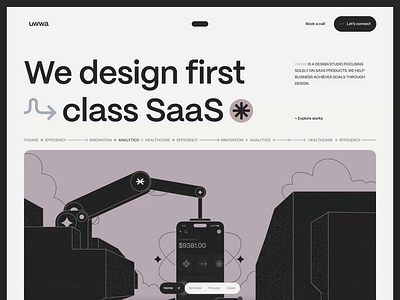Modern Internet Site Design That Records Attention and Transforms
In an increasingly electronic landscape, modern-day site design has actually emerged as a crucial element in capturing customer focus and driving conversions. As we discover these essential components, it becomes clear that comprehending their interplay can significantly influence an internet site's performance and user fulfillment.
Significance of Visual Pecking Order
Visual hierarchy is a vital aspect in website design, as it overviews users' focus and improves their overall experience. By purposefully arranging material, designers can guide individuals to the most crucial information initially, therefore enhancing involvement and enhancing usability.
Integrating a logical circulation in material arrangement is important; for instance, putting one of the most important info on top of a page promotes immediate acknowledgment. In addition, consistent use typography, such as differing font dimensions and designs, assists develop a clear content framework. This company not just aids in navigating yet also constructs count on, as customers feel a lot more comfortable when they can conveniently locate what they are searching for.
Inevitably, a well-executed visual hierarchy not only boosts aesthetic charm however additionally substantially influences user habits. By focusing on important aspects and ensuring a smooth experience, developers can efficiently transform site visitors into clients, reinforcing the value of this foundational style principle in contemporary site development.
Responsive Layout for All Devices
Creating a seamless experience across various gadgets is essential in today's electronic landscape, where individuals accessibility websites from desktops, smartphones, and tablet computers alike. Responsive design is a critical approach that guarantees sites adjust fluidly to various display dimensions, orientations, and resolutions. By utilizing versatile grids, pictures, and CSS media queries, developers can create formats that preserve visual integrity and performance, no matter the gadget being utilized.
The value of responsive design expands beyond appearances; it straight influences individual involvement and conversion prices. A website that works well on all devices motivates longer gos to and minimizes bounce rates, as individuals are most likely to connect with material that is very easy to navigate. In addition, online search engine, particularly Google, focus on mobile-friendly sites in their rankings, making responsive style a vital element of seo (SEO)
Including responsive style not just enhances customer experience but additionally enhances the growth process. By producing a solitary website that functions throughout tools, companies can conserve time and resources compared to establishing different mobile and desktop computer variations. Ultimately, receptive style is an essential approach for modern website layout, ensuring availability and fulfillment for all individuals, despite their device.
Involving Interactive Elements
While a responsive layout prepares for a practical internet site, incorporating engaging interactive elements is important for catching individual interest and promoting much deeper links. Website Design. Interactive aspects, such as animations, tests, and clickable infographics, develop a much more dynamic user experience, encouraging visitors to invest even more time on the website
Including interactive features can additionally guide individuals through complicated information, making it simpler to absorb content. Interactive sliders can illustrate product variants, while ingrained videos can supply presentations or endorsements that reverberate more than fixed images or text. Moreover, gamification methods, like incentives for completing tasks or involving with web content, can boost individual inspiration and retention.
Reliable use interactive components not only enhances the user experience however can also lead to greater conversion rates. By making communications interesting and pleasurable, businesses can grow a sense of loyalty and trust fund with their you could look here audience. Nonetheless, it is vital to balance interactivity with efficiency; excessively complicated features might hinder website speed, adversely impacting user complete satisfaction. Inevitably, integrating properly designed interactive aspects can dramatically elevate a site's efficacy, driving involvement and conversions in today's competitive digital landscape.
Structured Navigating Practices
Reliable navigating is a keystone of any kind of effective internet site, as it straight affects user experience and web content accessibility. Streamlined navigation practices guarantee that individuals can quickly find details, boosting their communication with the website. A well-structured navigation menu should be straightforward and user-friendly, typically including a limited variety of primary groups to avoid frustrating site visitors.
To accomplish streamlined navigating, designers ought to focus on an ordered framework that rationally arranges content. Applying breadcrumb routes can provide customers with context regarding their current area within the website, enabling smooth backtracking. Furthermore, using drop-down menus can efficiently preserve room while still supplying access to subcategories.
Responsive style is critical, as navigating needs to be functional across all devices (Website Design). Mobile here customers, specifically, gain from touch-friendly menus and collapsible areas that preserve use without jeopardizing aesthetics

Efficient Call-to-Action Methods
A well-crafted call-to-action (CTA) is important for leading individuals towards wanted results on an internet site, as it urges them to engage with web content or buy. To maximize their performance, CTAs ought to be clear, engaging, and tactically put throughout the site.
First, utilize action-oriented language that communicates necessity or worth, such as "Get going," "Join Now," or "Insurance claim Your Price cut." This language not just inspires customers however likewise establishes clear expectations concerning the next actions.
Second, consider layout elements; CTAs should stick out aesthetically with contrasting colors, ample whitespace, and famous positioning. A button that is easy to see and click rises the chance of user interaction.
In addition, personalizing CTAs based upon user behavior or demographics can dramatically improve engagement. Customized messages resonate extra with users, driving higher conversion rates.

Conclusion
These elements jointly improve customer experience, making certain that site visitors remain involved and inspired to explore web content even more. By prioritizing this these style principles, organizations can considerably enhance individual retention and conversion rates, inevitably leading to higher success in the digital landscape.
In a progressively digital landscape, modern-day website layout has actually arised as a critical factor in catching user focus and driving conversions.Aesthetic power structure is a vital component in site layout, as it guides customers' interest and enhances their general experience.The importance of responsive layout prolongs past appearances; it directly impacts user involvement and conversion rates.Integrating receptive layout not just boosts user experience but additionally simplifies the advancement procedure. Eventually, receptive style is a fundamental strategy for modern-day site style, guaranteeing accessibility and contentment for all users, no matter of their gadget.
 Jason J. Richter Then & Now!
Jason J. Richter Then & Now! Sydney Simpson Then & Now!
Sydney Simpson Then & Now! Monica Lewinsky Then & Now!
Monica Lewinsky Then & Now! Traci Lords Then & Now!
Traci Lords Then & Now! Lucy Lawless Then & Now!
Lucy Lawless Then & Now!